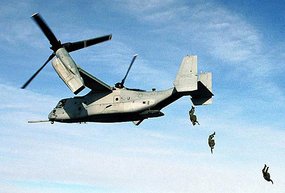V-22 Osprey
|
|
| V-22 Osprey | ||
|---|---|---|
| Description | ||
| Role | Multi-role aircraft | |
| Crew | 3 (2 pilots, crewman) + 24 troops | |
| Dimensions | ||
| Length | 56 ft 10 in | 17.33 m |
| Height | 17 ft 4 in | 5.28 m |
| Weights | ||
| Empty | 31,772 lb | 14,411 kg |
| Maximum take-off | 47,500 lb (VTOL) 55,000 lb (STOL) | 21,546 kg 24,947 kg |
| Powerplant | ||
| Engines | ||
| Power | 6,150 shp each | 4.6 MW each |
| Performance | ||
| Combat range | 1,249 mi | 2,011 km |
| Ferry range | 2,417 mi | 3,889 km |
| Armament | ||
The V-22 Osprey is a joint service, multi-mission aircraft with vertical take-off and landing (VTOL) capability. It is designed to perform VTOL missions like a conventional helicopter while also having the long-range cruise abilities of a twin turboprop aircraft.
The Osprey is the world's first production tiltrotor aircraft with a 38 ft (12 m) rotor, engine, and transmission nacelle mounted on each wing tip. It can operate as a helicopter when taking off and landing vertically. Once airborne, the nacelles rotate forward 90 degrees for horizontal flight, converting the V-22 to a high-speed, fuel-efficient turboprop airplane. The wing rotates for compact storage aboard ship.
The United States Marine Corps is the lead service in the development of the V-22 Osprey. The Marine Corps version, the MV-22B, will be an assault transport for troops, equipment and supplies, and will be capable of operating from ships or from expeditionary airfields ashore. The US Navy's HV-22A will provide combat search and rescue, delivery and retrieval of special warfare teams along with fleet logistic support transport. The CV-22A operated by the United States Special Operations Command (USSOCOM) will conduct long-range special operations missions. The V-22 Osprey will replace the Marine Corps CH-46E and CH-53D as well as several types of the Special Operations Command CH-53 Super Stallion, CH-47 Chinook, UH-60 Black Hawk, and C-130 Hercules series aircraft.
Development
The Osprey's development process has been long and controversial. The first flight occurred in March 1989. Since then however there have been four significant failures during testing - a crash in 1991, a second in 1992 that killed seven, a third in April 2000 that killed 19, and a fourth in December 2000 that killed four. Problems identified in all of these mishaps have been addressed by the V-22 program office and advocates of the program are optimistic that the aircraft is mature enough for fleet operations.
The cause of the April 2000 crash was investigated, and determined to be due to the rate of descent of over 2000 feet per minute (600 m/min) of the aircraft while at slow horizontal speeds of around 30 knots (56 km/h). Descending too fast at slow horizontal speed in helicopter mode can cause the airflow over the rotor blades to enter a Vortex ring state (VRS). While this phenomenon is present in all rotary-wing aircraft, it is believed that the Osprey may be more susceptible to it. Because of the side-by-side configuration of the Osprey's turbines, the Osprey may theoretically roll violently if one rotor enters VRS and the other does not; it is also argued that the Osprey will offer less warning of VRS than a conventional helicopter and may be more difficult to recover if it does. The Osprey's flight operations rules already restricted the Osprey to an 800 feet per minute (240 m/min) descent at lower than 40 knots (74 km/h) airspeed; in the wake of the accident this was further tightened to an 800 ft/min (240 m/min) descent whenever the rotors were tilted at more than 80 degrees to the horizontal. Another factor that may trigger VRS is helicopters operating in close proximity, a concern given the likely missions for the Osprey. The Marine evaluators have concluded that the restrictions imposed do not impede the mission of the craft in any way.
The Osprey is currently in its final operational evaluation (OPEVAL) prior to a full rate production decision. This OPEVAL has, thus far, been extremely successful; events have included long range deployments, high altitude, desert and shipboard operations. This final exam is scheduled for completion in June 2005.
Planned purchases include 360 for the Marine Corps, 48 for the Navy and 50 for the Air Force and 4 for the Texas Air National Guard.
General characteristics
- Primary function: Vertical takeoff and landing (VTOL) aircraft
- Contractor: Bell-Boeing
- Propulsion: Two pivoting Rolls-Royce/Allison AE 1007 engines
- Main rotor diameter: 38 ft (11.58 m)
- Blades per rotor: 3
- Weight: 60,500 lb (27 t) max gross weight
- Ceiling: 25,000 ft (7,600 m) service ceiling
- Speed: 272 knots (500 km/h) cruise
- Armament: Provisions for two .50 cal (12.7 mm) cabin guns or 7.62 x 51 mm miniguns
External links
- discussion of V-22 VRS accident (http://www.globalsecurity.org/military/systems/aircraft/v-22-vrs.htm)
Osprey_firing_flares.jpg
|
Lists of Aircraft | Aircraft manufacturers | Aircraft engines | Aircraft engine manufacturers Airports | Airlines | Air forces | Aircraft weapons | Missiles | Timeline of aviation |

